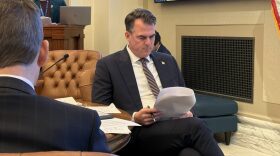After a presidentially declared disaster like last year’s tornadoes in Central Oklahoma, the U.S. Small Business Administration often steps in, offering low-interest loans to help homeowners and businesses recover. But the SBA has been criticized in the past for being slow to respond. And following the 2013 storms in the Sooner State, many people still have complaints about the process.
Scott Burkhart lived just a few blocks from Moore’s Briarwood Elementary School when the May 20th tornado leveled his home. A few days later, he received a letter in the mail from the Small Business Administration, advertising a low-interest loan to help him get back on his feet. He was hesitant to act on it, though.
“Nobody wants to take out a loan on top of already paying a mortgage, so I kind of set that aside and tried to go through the FEMA route,” Burkhart said.
But FEMA turned him down, and the payment he got from his insurance company wasn’t enough to build back his house. Left with few other options, he reluctantly applied to the SBA.
“There’s so much paperwork involved. It's almost ridiculous,” he said.
Burkhart was eventually approved for a loan of just over $100,000, but it was a long process. He wasn’t able to wrap up the paperwork with the SBA until this April, almost a year after the storm. And he’s still kind of bitter.
“Although everybody tells you, ‘I'm here to help you. We're here for you,’ nobody's there for you.
SBA spokesman Mark Randle says the mounds of paperwork and lengthy waits are regrettable, but the agency needs to ensure accountability.
“The SBA is the primary source of federal funds to help private property owners repair or replace disaster-damaged property. Disaster loans are direct from the U.S. government, so we have a dual stewardship to both the taxpayers and the disaster victims,” Randle said.
Burkhart’s frustrations are shared by many storm survivors in Central Oklahoma. Glenn Lewis of Lewis Jewelers in Moore thinks the SBA folks were well intentioned, but he calls the loan application process misleading at best.
“Every time I would have conversations and ask what the interest rate was, they' d say, ‘We don't know that yet. We can't tell you that,’” Lewis said.
Finally, after six weeks of filling out form after form, the SBA approved his loan, but with an interest rate nearly 2 percent higher than he could’ve gotten elsewhere in his city. Needless to say, he didn’t take them up on their offer.
Overall, the agency approved more than 900 totaling nearly $50 million after the 2013 storms. But less than half of that money has actually been disbursed.
Glenn Lewis says he isn’t surprised that many applicants would decide in the end not to take all the funding they were awarded.
“You spend all this time and all this effort and all the while they're dangling this carrot out there as if you're going to get a 1 percent note or something. And then they come back and say, "No, your rate is going to be about 6 percent.’ Well that's not a bargain, that's not a good deal,” Lewis said.
The SBA’s Mark Randle says business loans usually have a 4 percent interest rate, and he can’t speak to why Lewis Jeweler’s was higher. As for the complaints, he says improvement is an ongoing process.
Glenn Lewis was lucky. He was able to tap into his savings rather than rely on the government for aid. But he fears that if he had really needed the loan, the higher interest rate combined with the long wait time could’ve meant bankruptcy for his business.
-----
The Oklahoma Tornado Project is made possible by a grant from the Corporation for Public Broadcasting.Oklahoma Watch is a nonprofit, nonpartisan organization that produces in-depth and investigative journalism on a range of public-policy issues facing the state. For more Oklahoma Watch content, go to www.oklahomawatch.org.
Oklahoma Watch is a nonprofit, nonpartisan organization that produces in-depth and investigative journalism on a range of public-policy issues facing the state. For more Oklahoma Watch content, go to www.oklahomawatch.org.
As a community-supported news organization, KGOU relies on contributions from readers and listeners to fulfill its mission of public service to Oklahoma and beyond.Donate online, or by contacting our Membership department.








